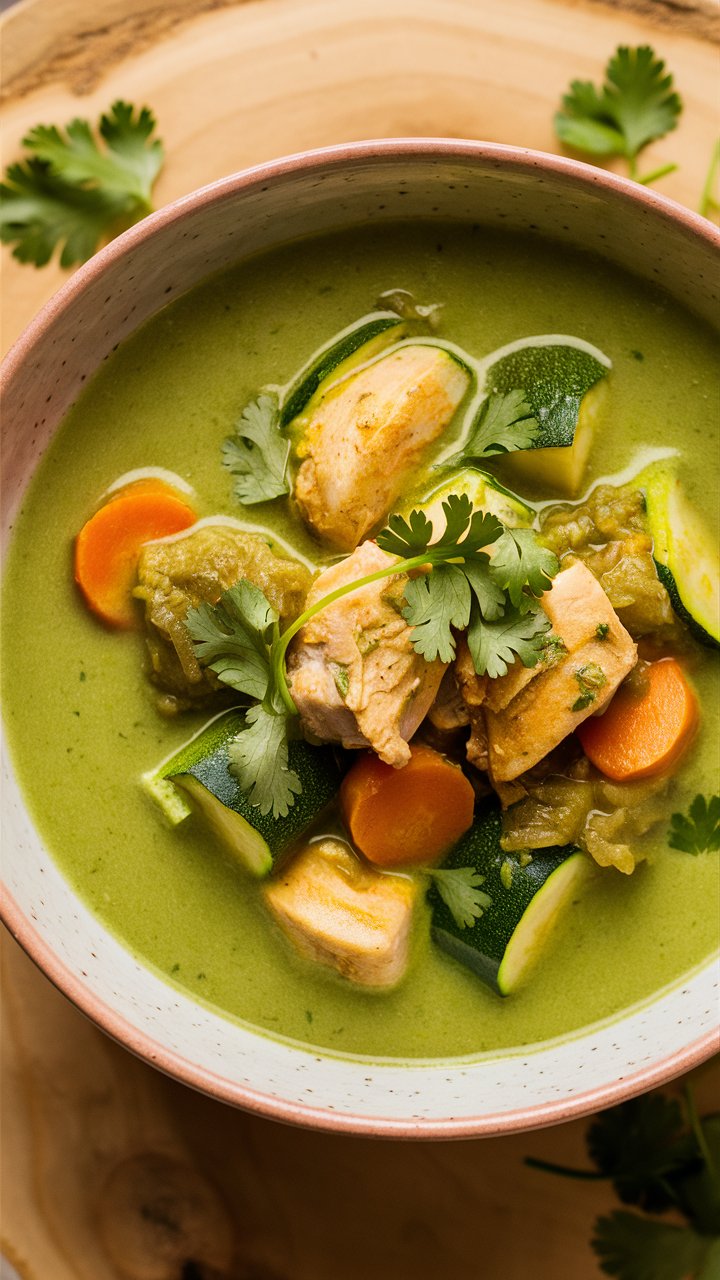
Thai Green Curry Chicken – The Ultimate Homemade Recipe and Guide 2025
Thai cuisine has a magical way of awakening the senses. It is simultaneously bold and delicate, fragrant and comforting. Among its many beloved dishes, Thai Green Curry Chicken stands out as a vibrant one-pot meal that effortlessly combines silky coconut milk, fragrant herbs, tender chicken, and crisp vegetables.
This guide is designed to be the ultimate resource—covering everything from ingredient selection and cultural context to detailed cooking steps, helpful variations, and expert tips. Whether you are new to Thai cooking or a seasoned home chef, you will find inspiration and confidence to create a dish that delights both the palate and the eye.
1. Introduction to Thai Green Curry
Thai green curry, known in Thailand as Gaeng Keow Wan, is one of the country’s most famous curries. Its name comes from the naturally green color of the curry paste—made with green chilies, fresh herbs, and aromatic spices. Traditionally, this dish showcases a beautiful interplay of heat, sweetness, and herbal brightness.
What makes it especially appealing to home cooks is its versatility. With the right ingredients, you can prepare a deeply flavorful curry in less than 30 minutes, yet it tastes as if you spent hours layering flavors. The star of our version is chicken, a lean protein that cooks quickly and pairs beautifully with the creamy coconut base.
2. Key Ingredients and Their Roles
The soul of green curry lies in the freshness of its ingredients. Below is a detailed look at what you will need and how each component contributes to the final dish.
Protein
- Chicken Breast or Thighs:
Chicken breast offers lean protein and cooks in minutes. Thighs provide a juicier bite and richer flavor. Either works perfectly—choose based on your preference.
Coconut Milk
- Full-Fat Coconut Milk:
Essential for the luscious, creamy texture. Look for brands with minimal additives. If you prefer a lighter curry, you can use reduced-fat coconut milk, but the sauce will be thinner.
Thai Green Curry Paste
- The heartbeat of this dish. Store-bought pastes vary in spiciness, so start with a modest amount and adjust. For authenticity, select a paste that includes ingredients like kaffir lime leaves, galangal, lemongrass, and shrimp paste.
Aromatics
- Garlic and Fresh Ginger:
Create the foundation of flavor and add warmth. - Onion or Shallots:
Provide gentle sweetness and depth.
Vegetables
- Carrots and Zucchini:
Offer color, natural sweetness, and texture. - Optional Additions: Bell peppers, snap peas, baby corn, spinach, or mushrooms can all join the party.
Herbs and Finishers
- Fresh Cilantro and Thai Basil:
Brighten the curry with herbal fragrance. - Fresh Lime Juice:
A squeeze of citrus cuts through the richness and awakens the dish.
Seasonings
- Fish Sauce or Light Soy Sauce:
Adds umami and saltiness. - Palm Sugar or Brown Sugar:
Balances heat and acidity.
3. Equipment You’ll Need
You do not need any fancy gadgets, but having the right tools streamlines the process.
- Large, heavy skillet or wok
- Sharp chef’s knife
- Cutting board
- Wooden spoon or heat-proof spatula
- Measuring cups and spoons
4. Step-by-Step Cooking Instructions
Below is a detailed, foolproof method to create your Thai Green Curry Chicken. These instructions expand on basic recipes to give you confidence and precision.
Step 1: Prepare Ingredients
Dice chicken into bite-sized pieces. Slice vegetables evenly so they cook uniformly. Mince garlic and ginger. Have your curry paste measured and ready.
Step 2: Sauté Aromatics
Heat two tablespoons of coconut oil (or a neutral oil like grapeseed) in a large skillet over medium-high heat. Add diced onion or shallot and cook for about 5 minutes until softened and lightly golden.
Step 3: Brown the Chicken
Add the chicken pieces to the pan. Season lightly with salt and pepper. Cook for 4–5 minutes, stirring occasionally, until the edges are opaque. You don’t need to cook the chicken fully at this stage.
Step 4: Bloom the Spices
Add the minced garlic, grated ginger, and a pinch of ground coriander. Stir constantly for 1 minute. This quick step releases essential oils and deepens the flavor.
Step 5: Build the Curry Sauce
Pour in a can of full-fat coconut milk and stir to combine. Add two to three tablespoons of Thai green curry paste. Start with less if you prefer mild heat; you can always add more.
Slip in your vegetables—carrots first (they take longer), followed by zucchini or other quick-cooking vegetables.
Step 6: Simmer
Reduce heat to medium-low and let the mixture simmer gently for 7–10 minutes. The sauce will thicken slightly, the chicken will finish cooking, and the vegetables will become tender-crisp.
Step 7: Finish with Brightness
Turn off the heat. Stir in the juice of one fresh lime and a generous handful of chopped cilantro or Thai basil. Taste and adjust seasoning: more fish sauce for saltiness, a teaspoon of sugar for sweetness, or additional curry paste for heat.
Step 8: Serve
Ladle the curry over steamed jasmine rice or scoop it up with warm naan or roti. Garnish with extra herbs and a few slices of fresh chili if you enjoy spice.
5. Mastering Flavor Balance
Great Thai food is all about harmony between sweet, salty, sour, and spicy. Here’s how to adjust your curry:
- Too Spicy? Add more coconut milk or a pinch of sugar to soften the heat.
- Too Rich? Squeeze in extra lime juice or add a splash of vegetable broth.
- Too Mild? Stir in an extra teaspoon of curry paste or a finely chopped green chili.
- Not Salty Enough? A dash of fish sauce or soy sauce can round out the flavor.
6. Serving Suggestions and Pairings
Thai Green Curry is versatile enough to shine in many settings:
- Steamed Jasmine or Basmati Rice: Classic and ideal for soaking up the sauce.
- Coconut Rice: Cook rice with a little coconut milk for extra richness.
- Flatbreads: Naan, roti, or paratha make excellent scooping companions.
- Fresh Sides: A cucumber salad with rice vinegar dressing or a simple green papaya salad provides a refreshing contrast.
- Drinks: Thai iced tea, sparkling water with lime, or a crisp white wine such as Riesling pairs beautifully.
7. Creative Variations and Substitutions
One of the best things about this dish is its flexibility. Consider these ideas:
- Vegetarian or Vegan: Swap chicken for tofu, tempeh, or chickpeas and use soy sauce instead of fish sauce.
- Seafood Twist: Add shrimp or firm white fish in the last 5 minutes of simmering.
- Extra Vegetables: Include bell peppers, snow peas, baby eggplant, or spinach for added color and nutrients.
- Different Curry Pastes: Try red or yellow curry paste for a new flavor profile.
- Low-Carb Option: Serve with cauliflower rice or zucchini noodles.
8. Tips for Meal Prep, Storage, and Reheating
This curry tastes even better the next day as the flavors meld.
- Refrigeration: Store in an airtight container for up to 4 days.
- Freezing: Freeze in portions for up to 2 months. Thaw overnight in the refrigerator before reheating.
- Reheating: Warm gently on the stovetop over low heat, adding a splash of coconut milk if the sauce has thickened.
9. Nutritional Insights
A serving of Thai Green Curry Chicken (about 1 cup with rice) typically provides:
- Calories: ~350–450 depending on coconut milk and rice portions
- Protein: 25–30 grams
- Healthy Fats: From coconut milk and a small amount of oil
- Vitamins & Minerals: Rich in vitamin A, vitamin C, potassium, and antioxidants from fresh herbs and vegetables
These numbers will vary, but overall the dish offers a balanced combination of protein, healthy fats, and vegetables.
10. Frequently Asked Questions
Can I use light coconut milk?
Yes, but expect a thinner sauce and slightly less richness.
Is green curry very spicy?
Heat levels vary by brand of curry paste. Start with two tablespoons and add more if you enjoy a kick.
Can I prepare it ahead of time?
Absolutely. Make the curry up to a day in advance and refrigerate. Reheat gently before serving.
What if I can’t find Thai basil?
Regular sweet basil works, though it lacks the subtle anise flavor. Cilantro is also a fine substitute.
Can I use pre-cooked chicken?
Yes, stir it in during the final simmer to warm through.
11. Final Thoughts and Cooking Inspiration
Thai Green Curry Chicken captures the essence of Thai cooking: a celebration of balance and freshness. By following this guide, you can create a dish that rivals your favorite takeout while remaining fully customizable to your taste and dietary needs.
Experiment with vegetables, adjust the spice level, and explore different herbs to make the dish uniquely yours. With just a few pantry staples and fresh produce, you can bring the aromatic streets of Bangkok into your own kitchen.
Cook it once, and you will likely add it to your regular rotation. Share it with friends, pair it with a chilled drink, and savor the harmony of flavors that make Thai cuisine beloved worldwide.

